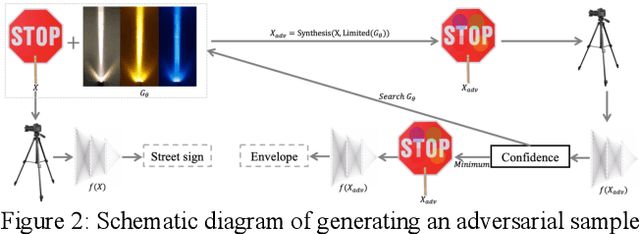Kalibinuer Tiliwalidi
Multi-View Black-Box Physical Attacks on Infrared Pedestrian Detectors Using Adversarial Infrared Grid
Jul 01, 2024Abstract:While extensive research exists on physical adversarial attacks within the visible spectrum, studies on such techniques in the infrared spectrum are limited. Infrared object detectors are vital in modern technological applications but are susceptible to adversarial attacks, posing significant security threats. Previous studies using physical perturbations like light bulb arrays and aerogels for white-box attacks, or hot and cold patches for black-box attacks, have proven impractical or limited in multi-view support. To address these issues, we propose the Adversarial Infrared Grid (AdvGrid), which models perturbations in a grid format and uses a genetic algorithm for black-box optimization. These perturbations are cyclically applied to various parts of a pedestrian's clothing to facilitate multi-view black-box physical attacks on infrared pedestrian detectors. Extensive experiments validate AdvGrid's effectiveness, stealthiness, and robustness. The method achieves attack success rates of 80.00\% in digital environments and 91.86\% in physical environments, outperforming baseline methods. Additionally, the average attack success rate exceeds 50\% against mainstream detectors, demonstrating AdvGrid's robustness. Our analyses include ablation studies, transfer attacks, and adversarial defenses, confirming the method's superiority.
Adversarial Infrared Geometry: Using Geometry to Perform Adversarial Attack against Infrared Pedestrian Detectors
Mar 06, 2024Abstract:Currently, infrared imaging technology enjoys widespread usage, with infrared object detection technology experiencing a surge in prominence. While previous studies have delved into physical attacks on infrared object detectors, the implementation of these techniques remains complex. For instance, some approaches entail the use of bulb boards or infrared QR suits as perturbations to execute attacks, which entail costly optimization and cumbersome deployment processes. Other methodologies involve the utilization of irregular aerogel as physical perturbations for infrared attacks, albeit at the expense of optimization expenses and perceptibility issues. In this study, we propose a novel infrared physical attack termed Adversarial Infrared Geometry (\textbf{AdvIG}), which facilitates efficient black-box query attacks by modeling diverse geometric shapes (lines, triangles, ellipses) and optimizing their physical parameters using Particle Swarm Optimization (PSO). Extensive experiments are conducted to evaluate the effectiveness, stealthiness, and robustness of AdvIG. In digital attack experiments, line, triangle, and ellipse patterns achieve attack success rates of 93.1\%, 86.8\%, and 100.0\%, respectively, with average query times of 71.7, 113.1, and 2.57, respectively, thereby confirming the efficiency of AdvIG. Physical attack experiments are conducted to assess the attack success rate of AdvIG at different distances. On average, the line, triangle, and ellipse achieve attack success rates of 61.1\%, 61.2\%, and 96.2\%, respectively. Further experiments are conducted to comprehensively analyze AdvIG, including ablation experiments, transfer attack experiments, and adversarial defense mechanisms. Given the superior performance of our method as a simple and efficient black-box adversarial attack in both digital and physical environments, we advocate for widespread attention to AdvIG.
Adversarial Camera Patch: An Effective and Robust Physical-World Attack on Object Detectors
Dec 11, 2023Abstract:Nowadays, the susceptibility of deep neural networks (DNNs) has garnered significant attention. Researchers are exploring patch-based physical attacks, yet traditional approaches, while effective, often result in conspicuous patches covering target objects. This leads to easy detection by human observers. Recently, novel camera-based physical attacks have emerged, leveraging camera patches to execute stealthy attacks. These methods circumvent target object modifications by introducing perturbations directly to the camera lens, achieving a notable breakthrough in stealthiness. However, prevailing camera-based strategies necessitate the deployment of multiple patches on the camera lens, which introduces complexity. To address this issue, we propose an Adversarial Camera Patch (ADCP).
Adversarial Neon Beam: Robust Physical-World Adversarial Attack to DNNs
Apr 02, 2022



Abstract:In the physical world, light affects the performance of deep neural networks. Nowadays, many products based on deep neural network have been put into daily life. There are few researches on the effect of light on the performance of deep neural network models. However, the adversarial perturbations generated by light may have extremely dangerous effects on these systems. In this work, we propose an attack method called adversarial neon beam (AdvNB), which can execute the physical attack by obtaining the physical parameters of adversarial neon beams with very few queries. Experiments show that our algorithm can achieve advanced attack effect in both digital test and physical test. In the digital environment, 99.3% attack success rate was achieved, and in the physical environment, 100% attack success rate was achieved. Compared with the most advanced physical attack methods, our method can achieve better physical perturbation concealment. In addition, by analyzing the experimental data, we reveal some new phenomena brought about by the adversarial neon beam attack.
 Add to Chrome
Add to Chrome Add to Firefox
Add to Firefox Add to Edge
Add to Edge